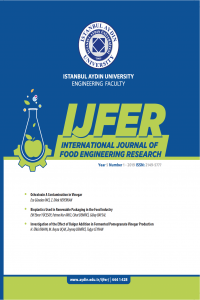COMPARISON OF FOOD SAFETY MANAGEMENT SYSTEMS
COMPARISON OF FOOD SAFETY MANAGEMENT SYSTEMS
Food Safety, , ISO 22000, , HACCP, BRC, IFS,
___
- [1] Giray veand Soysal, 2007. Türkiye’ de Gıda Güvenliği ve Mevzuatı, TSK Koruyucu Hekimlik Bülteni, 6(6), 485-490, İzmir
- [2] Tayyar, M., 2010. Gıda Güvenliği Ders Kitabı, 22-36, İstanbul: Tc. Marmara Belediyeler Birliği Yayını
- [3] Onurlubaş, E., 2015. ‘Tüketicilerin Gıda Güvenliği Konusunda Bilinç Düzeylerinin Ölçülmesi Tokat İli Örneği’, (Ph.D. thesis), Ankara.
- [4] Başaran, B., 2016. ISO 22000 Gıda Güvenliği Yönetim Sistemi, Journal of Food Health Science, 2(1), 9-26, Rize.
- [5] Koçak, N., 2007. ISO 22000: Gıda Güvenliği Yönetim Sistemleri Uygulama Sürecinde Temel Adımlar, Dokuz Eylül Üniversitesi Sosyal Bilimler Enstitüsü Dergisi, 9(4), 135-159.
- [6] Belibağlı veand Dalgıç, 2006. Gıda Güvenliği ve Kalite Yönetim Sistemleri Entegrasyonu ISO 22000:2005 Gıda Güvenliği Yönetim Sistemi ve ISO 9000:2000 Kalite Yönetim Sistemi Uygulamaları, Türkiye 9. Gıda Kongresi, Bolu, 24-26 May 2006.
- [7] TS EN ISO 22000, 2005. Gıda Güvenliği Yönetim Sistemleri, Gıda Zincirindeki Tüm Kuruluşlar İçin Şartlar, Türk Standardı, TSE, Ankara.
- [8] BRc, 2015. Gıda Güvenliği Global Standardı, British Retail Consortium Version 7, Londra.
- [9] IFS, 2014. Gıda Ürünlerinin Kalite ve Gıda Güvenliğini Denetleme Standardı, International Featured Standarts Versiyon 6, Almanya.
- [10] Kırdar and Kurşun, 2008. ISO 22000 Gıda Güvenliği Yönetim Sistemi, Türkiye 10. Gıda Kongresi, Erzurum, 21-23 May 2008.
- [11] Anonymous , 2005. http://www.-informdanismanlik.com /22000 . html (Date of Access: 05.04.2017).
- [12]Anonymous,2008. http://www.gidabilimi.com/ index.php/tr/forum-146/7-iso- 22000/1872-haccpve- iso-22000-arasindaki-farklar-iso-22000-ingetirdigi- yenilikler (Date of Access: 05.04.2017).
- [13] Anonymous, 2009 . h t t p : / / w w w . e g i t t i m . c o m / i n d e x . php?option=comcontent&view=article&id= 128:isohaccpfarki&catid=53:mutfaktahijyen &Itemid=44 (Date of Access: 05.04.2017).
- [14] Anonymous, 2013. http://www.europlastiques. com/news/69-iso-22000-brc-and-ifs-thedifference. html#. WOH9vfnyipo (Date of Access: 05.04.2017).
- ISSN: 2149-5777
- Başlangıç: 2015
- Yayıncı: İstanbul Aydın Üniversitesi
PREPARETION OF SAFE FOODS IN HOSPITAL KITCHEN AND PATIENT NUTRITION
Nanotechnology and Smart Packaging in Food Packaging
AKKERMANSIA MUCINIPHILA; ,FUNCTIONAL AND PROBIOTIC PROPERTIES IN THE GASTROINTESTINAL TRACT
Murat DOĞAN, Merve ÖZTAĞ, Hilal DEMİRKESEN BIÇAK
